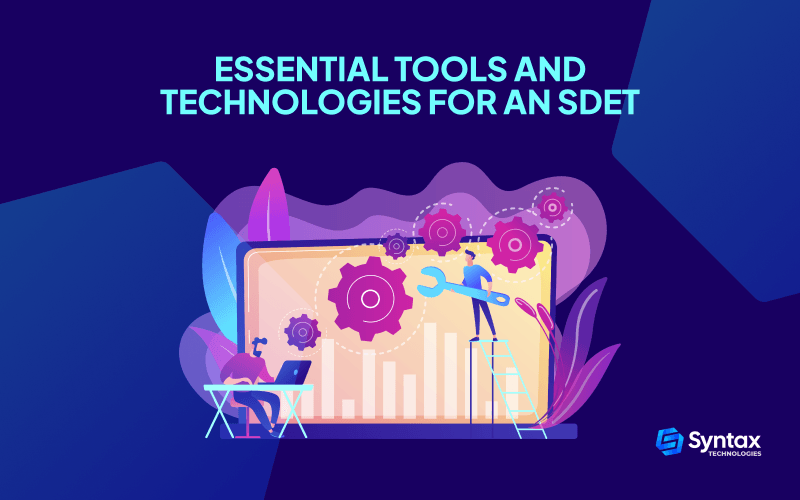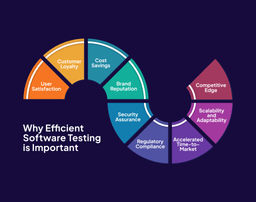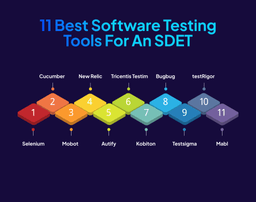In this fast-paced digital age where we’re all glued to our screens, the spotlight is firmly on user experience, the true king of the app realm!
Imagine one tiny glitch and poof! As revealed by PwC’s eye-opening report, you might lose a whopping 32% of your cherished users.
Now, let’s talk about loyalty, the heartbeat of any business. It’s a wild ride out there, and keeping your users hooked is no small feat. That’s where software testing swoops in as the unsung hero.
And guess what? You’re at the forefront of this exciting journey as an SDET.
Your daily mission is to make sure the digital realm runs like a well-oiled machine, and that’s where the magic of efficient SDET tools comes into play.
But hey, how do you know which SDET tools are the real MVPs in a sea of options?
Introducing our guide to the top 11 SDET tools that have earned their stripes in the software industry.
Get ready to dive into the tech wonderland and level up your SDET career! Join us at Syntax Technologies as we unwrap the latest in software testing because your journey in the tech world is about to get a turbo boost!
Why Efficient Software Testing is Important
There’s no denying that for every company, profits are crucial.
After all, you can’t go long without maintaining consistent positive cash flow. In the world of software, its all about dollars and sense. Inefficient coding reportedly cost US organizations a jaw-dropping $2.41 trillion in 2022 alone!
So, for an SDET engineer, you’re an essential player wielding immense significance for a myriad of reasons:
User Satisfaction
You’re the guardian of user satisfaction, the captain steering the ship toward a seamless and frustration-free experience for end-users. Bugs, glitches, and usability issues: You tackle them head-on, ensuring a superior user journey that’s as smooth as butter on hot toast.
Cost Savings
Catching and fixing issues early in the software development process is your secret weapon. Efficient testing doesn’t just save the day; it saves dollars. It’s like having a superhero’s ability to minimize the risk of costly errors, ensuring that resources are used wisely.
Customer Loyalty
Customer loyalty isn’t just a buzzword; it’s a treasure. A flawless software experience is the magic potion, and you, my friend, are the guardian of quality! You’re the one preventing trust issues and the dreaded customer churn. Because, let’s face it, acquiring new customers is like diving into an abyss of costs while keeping the existing ones happy, which is the real jackpot.
Brand Reputation
A single software hiccup and your brand reputation might take a nosedive. But fear not; efficient testing is here to be the superhero! It catches those pesky issues before they even say “hi” to the end users, keeping that brand image sparkling like a unicorn in a tech wonderland!
Security Assurance
In this era of cyber surprises, efficient testing is not just about finding vulnerabilities; it’s about building a fortress around sensitive user data and maintaining that sacred trust with your users. You’re not just testing code; you’re the guardian of digital fortresses!
Regulatory Compliance
Many industries have a rulebook thicker than a fantasy novel when it comes to data privacy and security. Efficient testing ensures your software is a law-abiding citizen, dodging legal troubles and hefty financial penalties. You’re not just testing; you’re the compliance champion!
Time-to-market, Scalability, and Adaptability
Efficient testing isn’t the villain extending development timelines; it’s the superhero automating tests, streamlining processes, and ensuring faster, more reliable releases. Who said testing can’t be the speed racer of the software world?
Competitive Edge
In a sea of software options, quality is your secret sauce. Efficient testing with up-to-date SDET tools ensures your software isn’t just meeting the basics; it’s outshining competitors in performance testing, reliability, and user experience. You’re not just testing code; you’re crafting a software masterpiece!
11 Best SDET Tools for Software Testing
Whether you’ve already started paving your way to become an SDET or you’re thinking about moving to an SDET position, here are some great examples of SDET tools to get you started:
Selenium
Selenium, a powerful web automation tool, seamlessly transforms browser interaction into efficient automation. Coupled with Java and the capabilities of Webdriver Selenium, you can effortlessly automate browser tasks. It acts as a virtual assistant for web testing, replacing manual efforts with automated precision. Bid farewell to laborious manual tests and welcome a streamlined, automated approach to web exploration.
Cucumber
Cucumber is the conduit connecting QA Automation engineers to the practical realm of Behavior-Driven Development (BDD). It functions as a translator, converting intricate test cases into clear English scenarios, making them understandable even to those without a technical background.
The synergy between Cucumber and Selenium is where the real magic occurs. This collaboration breathes life into your tests, enhancing them with unparalleled clarity and precision.
As Cucumber simplifies your testing process into a narrative of scenarios, you’ll adeptly navigate the intricate pathways of code validation. With Cucumber as your ally, QA Automation engineers assume the role of storytellers, crafting test cases that unfold seamlessly, akin to chapters in a compelling book.
Important note: Since both Cucumber and Selenium are open-source, you can download and use them without incurring any direct costs.
However, keep in mind that while the core SDET tools are free, there are paid plans like Cucumber Studio for additional services or tools that complement them. And Selenium Webdriver works with web-based applications like Firefox and Chrome but not window-based applications.
Mobot
Mobot is a comprehensive testing platform that utilizes mechanical robots for mobile device testing. This innovative approach empowers QA teams to transition tests, previously confined to manual processes, into automated routines facilitated by real robots.
The platform employs mechanical robots for mobile device testing, transforming manual tasks into automated routines. It’s a full-service testing platform that manages testing comprehensively. The development team and robot fleet handle execution, documentation, and reporting.
It also goes beyond traditional functional testing by incorporating real-world simulation scenarios for robust testing, identifying and mitigating potential issues pre-deployment.
It enables the creation of virtual environments, mimicking real-world conditions and user interactions, including actions like tapping, scrolling, swiping, and text input.
When it comes to comprehensive test reporting, the platform provides detailed reports and analysis of test results, pinpointing discrepancies, bugs, and performance issues.
It also automatically generates Jira tickets for identified issues and sends Slack messages with test results and reproducible steps, streamlining communication and issue resolution.
New Relic
New Relic is another SDET tool, mainly acting as a primary telemetry aggregator, importing comprehensive information about applications and networks.
CentralizedIt facilitates centralized data analysis, allowing for insights extraction using diverse features and AI support tools.
It provides backend monitoring, Kubernetes monitoring, specialized monitoring for mobile applications, model performance monitoring, infrastructure monitoring, log management, error tracking, network monitoring, vulnerability management, browser monitoring, and extensive integration options.
It also offers seamless integration with tools like Slack, Jira, and PagerDuty, with an API available for building custom integrations.
Autify
It’s a codeless AI automation testing platform, so if you don’t fancy working with codes or are a beginner in coding, this can serve as a good solution for automated testing.
Autify facilitates test creation, management, execution, and reporting, incorporating self-healing AI to expedite release cycles and enhance team productivity.
Its ideal for developers, product experts, QA teams, and marketers in rapidly growing organizations.
It has an intuitive UI for No-Code Testing and provides an interface for easy browser interaction, offering a no-code testing option suitable for everyone, with customization options for tests.
AI monitors UI changes with each release, automatically updating test scenarios and continuing element selection even with changed features.
Autify works for web and mobile native applications, offering a range of capabilities such as cross-browser testing, email testing, JavaScript steps, parallel execution, visual regression, and more.
It also seamlessly integrates with CI/CD tools, including CircleCI, Jenkins, and Slack.
Tricentis Testim
This platform is a low-code, end-to-end AI software testing tool designed for rapid scaling.
Tests can be edited in a visual editor, rearranging steps, creating reusable groups, and adding assertions or code-like functions.
There is seamless integration with major Continuous Integration (CI) systems, with features for test status handling during CI runs.
This platform integrates with popular version control systems for code/test branch synchronization and collaboration features for team-based testing. The dashboard displays the last ten runs for each test, aiding in quick diagnosis of failures.
It also includes JavaScript and visual editor, AI learning smart locators, project quality tracking, and native Salesforce ecosystem testing. Integrates seamlessly with common CI systems and IDEs.
Kobiton
Kobiton is known as a mobile-first software testing tool. Its comprehensive mobile app testing solution allows users to seamlessly construct, test, deploy, and launch mobile apps, websites, and IoT devices.
This versatile platform supports real device testing, accommodating on-premise setups or cloud-based configurations.
QA teams benefit from automated testing through an AI-driven scriptless solution and the convenience of AI-assisted test script generation, all within a unified platform.
Kobiton supports real device testing, automation testing through an AI-driven scriptless solution, and AI-assisted test script generation. Users can test across various devices and benefit from detailed activity logs and a smart app directory.
It offers seamless integration into major CI/CD platforms, including automatically creating JIRA tickets with full video of test failures.
You also gain access to an extensive device library, parallel automation execution, and extensive integration support with various software testing systems.
BugBug
This tool is low-code and mainly made for startups. Its user-friendly design ensures easy use, even for those without programming knowledge.
This tool is invaluable for swiftly expanding startups needing more in-house software testing expertise or capacity.
BugBug simplifies creating and automating test cases, providing a straightforward solution for testing needs.
It simplifies creating and automating test cases, offering browser and cloud test creation without coding skills. Tests can be fixed without re-recording, and automated tests can be scheduled daily.
There’s seamless integration with CI/CD pipelines, offering a scalable subscription model for both small teams and larger enterprises.
Its standout features include browser-based testing, no/low-code test management, parallel cloud test runs, email notifications, in-browser debugging, team collaboration functionality, and native integrations with GitHub, Jenkins, Travis CI, GitLab, BitBucket, and more, as well as Zapier connectivity.
Testsigma
This tool is most widely used for test automating mobile and web apps. The tool consolidates all the functionalities of a conventional and fragmented test stack into one cohesive space.
You get a direct cloud sign-up with no setup required and local deployment using a Docker image. You can create test scripts in simple English and record user actions, which are automatically converted to editable steps.
Moreover, you can run your tests directly on the cloud across various browsers and devices.
Plus, theres real-time results monitoring with check step-wise results during and after execution and detailed reports generated promptly post-execution. AI automatically fixes unstable elements and test steps, which minimizes the need for manual maintenance.
The platform is built with Java for stability. You can use Test Recorder to generate robust scripts for websites and native mobile apps. For recorder functionality, utilize the test recorder on your device farm/grid and leverage Testsigma’s built-in device lab on the cloud.
Testsigma’s standout features include built-in visual testing, codeless automation, parameterized/data-driven testing, the ability to manage global parameters, 2FA Testing that includes two-factor authentication testing, and seamless integration with CI tools.
You also get one-click integrations with popular tools like Jenkins, JIRA, Slack, and Trello. Other notable mentions include Azure DevOps, AWS, Bamboo Bugzilla, Kobiton, and MS Teams integrations.
testRigor
This tool includes codeless automation used for manual testing requiring minimal maintenance.
It offers comprehensive support for mobile testing. It also facilitates API call mocking, robust 2FA login support, web testing for both mobile and desktop, conditional executions, automatic accessibility testing, and seamless integration with CI/CD providers, Jira, TestRail, PagerDuty, and more.
Mabl
This platform is also a low-code software testing option one can choose if they’re not too comfortable with codes.
Technical and non-technical team members can contribute to test creation. Theres streamlined collaboration on a single cloud-native testing platform.
Mabl allows the integration of testing into existing workflows. Its compatible with issue tracking, CI/CD, communication tools, and more.
Mabl Trainer is designed for easy creation of tests. It enables the creation of tests based on key user flows in the application.
As tests execute, Mabl collects detailed diagnostic data. It generates AI-driven insights, increasing confidence in deployment.
There’s auto-healing functionality powered by AI, and tests learn and evolve with the application, adapting to changes.
Its standout features include Selenium import/export, cross-browser and mobile testing, machine learning auto-healing, and accessibility testing.
Mabl has native integrations with Jira, Bitbucket, Gitlab, GitHub, Postman, Slack, Microsoft Teams, Azure Pipelines, and more.
Ultimately, it offers extensive integration options through API connectivity.
Use the Latest SDET Testing Tools to Level Up Your Game
Did you catch the stars of the show? Those innovative tools and platforms are like superheroes in the testing universe.
Each tool flexes its unique strengths, ready to make your testing journey a true adventure!
But hey, it’s not just about flashy features it’s about simplicity, user-friendly vibes, and making testing a party that everyone’s invited to. Whether you’re a tech wizard or a non-tech whiz, these tools are all about empowerment, ensuring testing is a breeze for every stakeholder on the team.
Let’s talk about the future. As tech takes a quantum leap, these tools are offering robust solutions. They’re not just tools; they’re the backbone of agility and effectiveness in the world of software development and deployment.
So, whether you’re dreaming of scalable automation, diving into the world of cross-browser testing, or seamlessly integrating into your team’s groove, the tools we’ve explored showcase the diversity and sophistication that’s the heartbeat of today’s software testing landscape.
At Syntax Technologies, we wish you good luck as a potential SDET. Remember that we’re ready to provide you with the essential knowledge to get you started!


